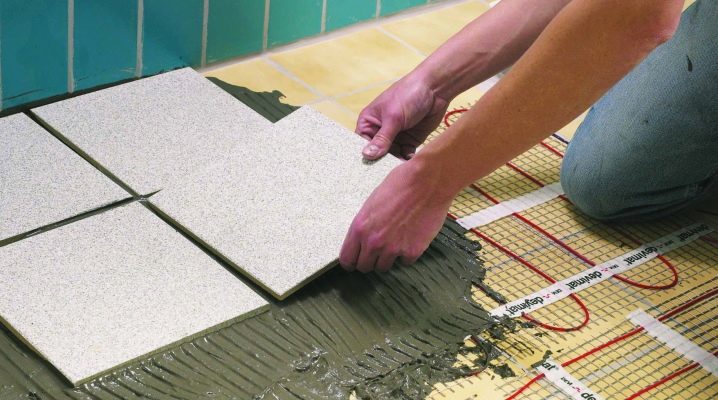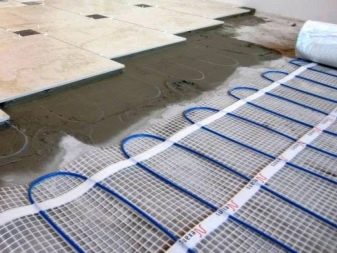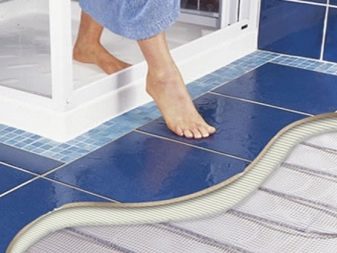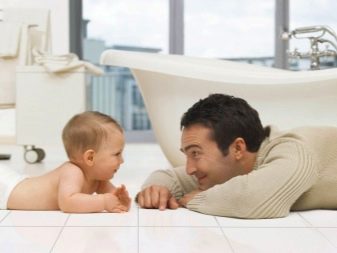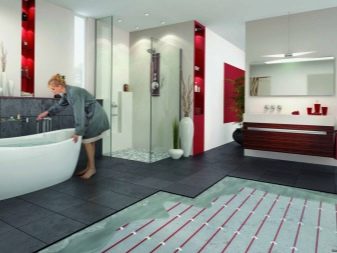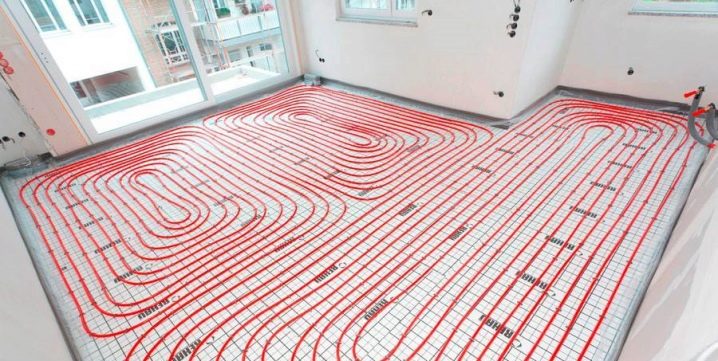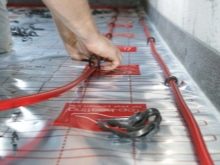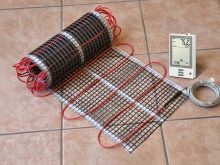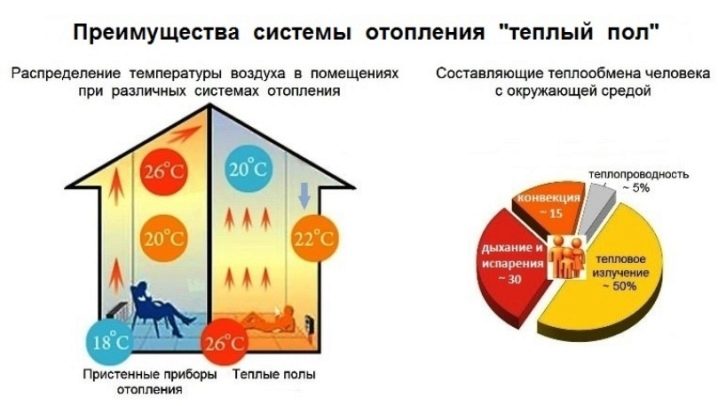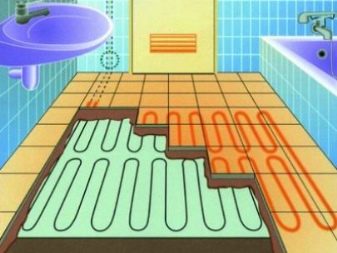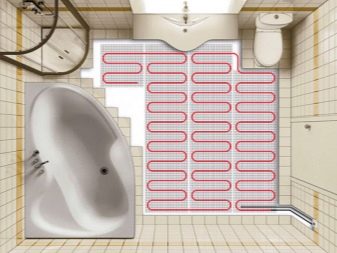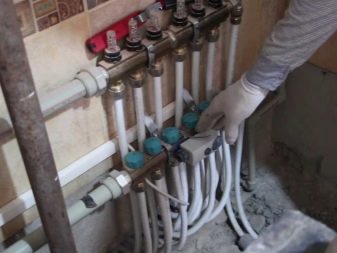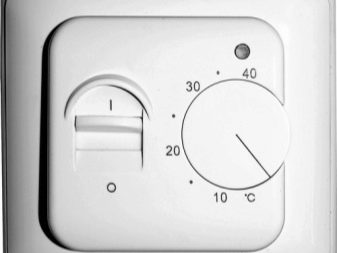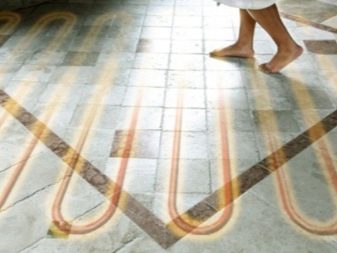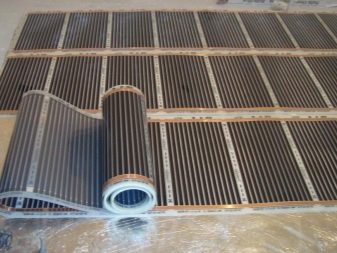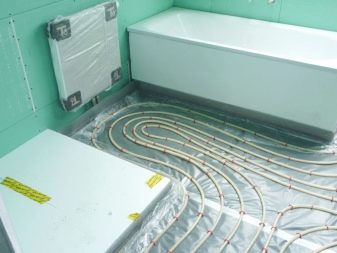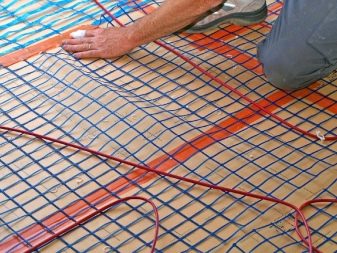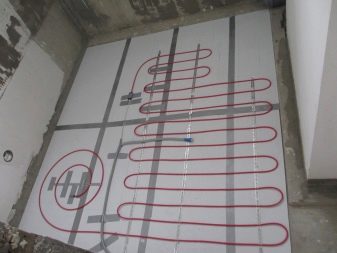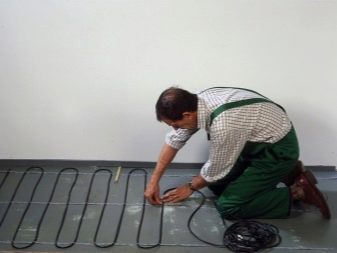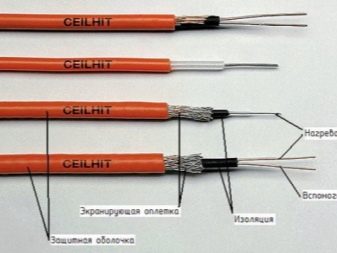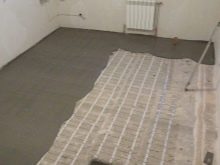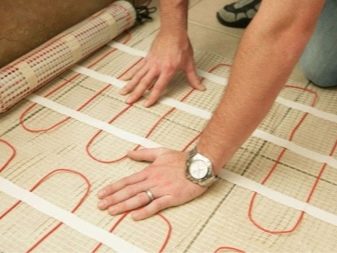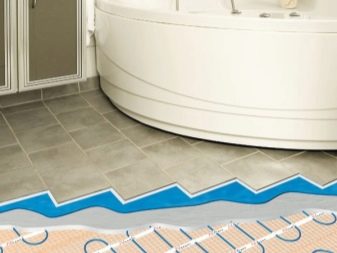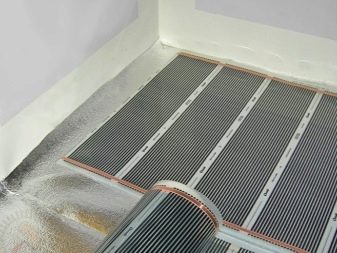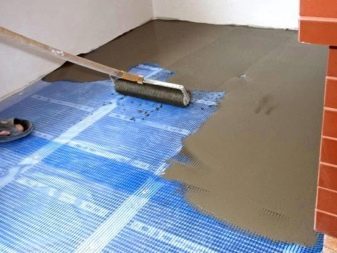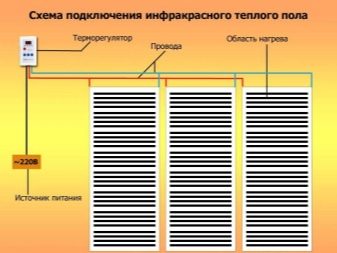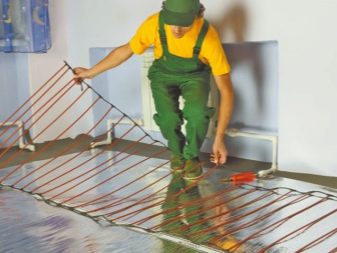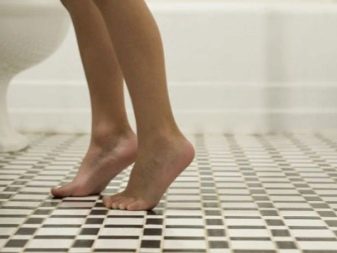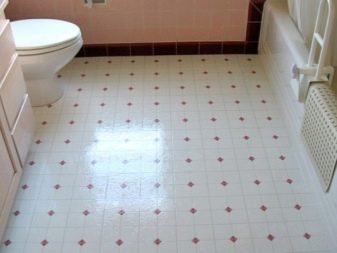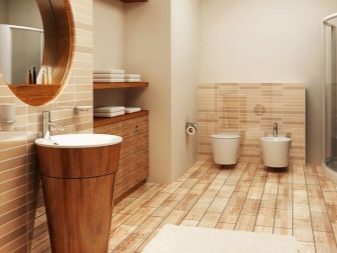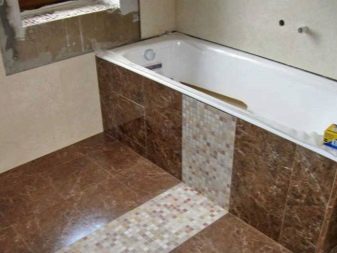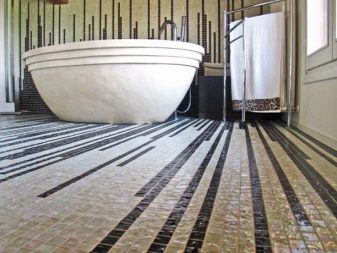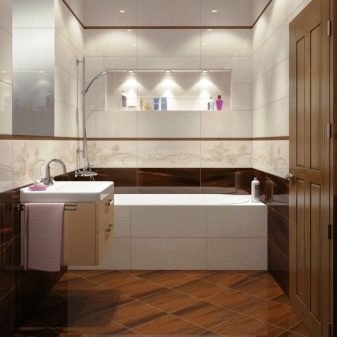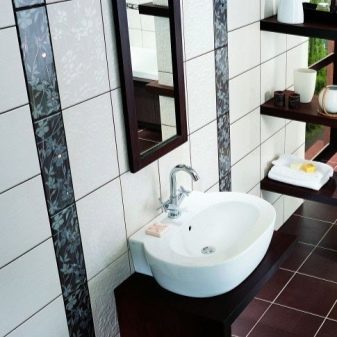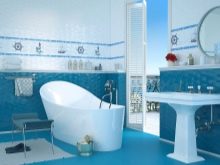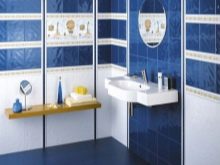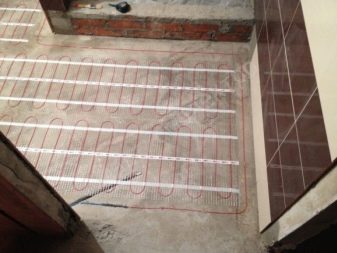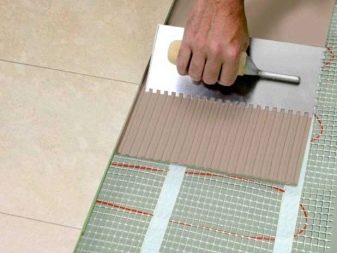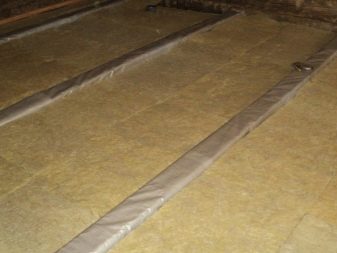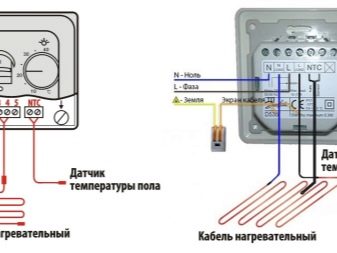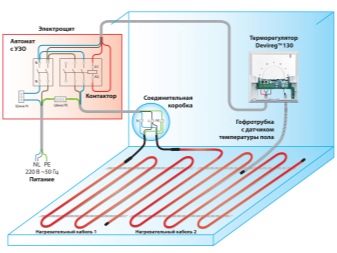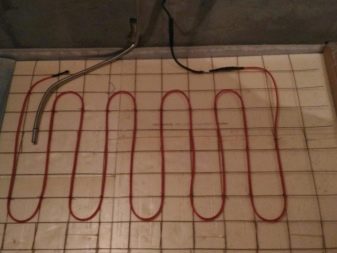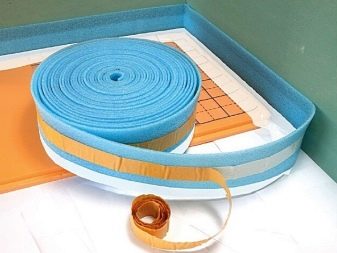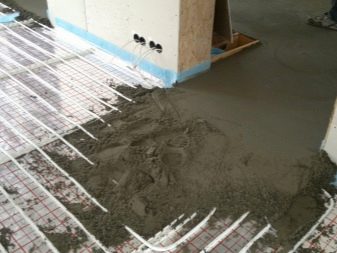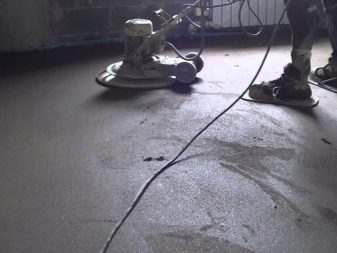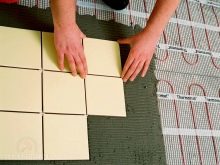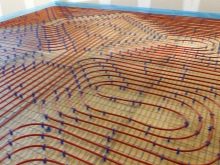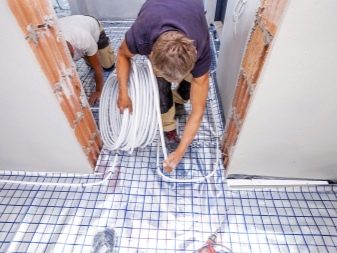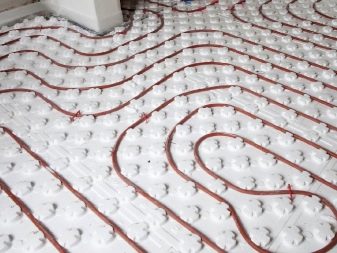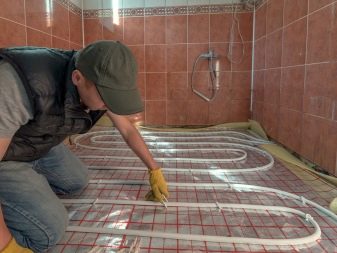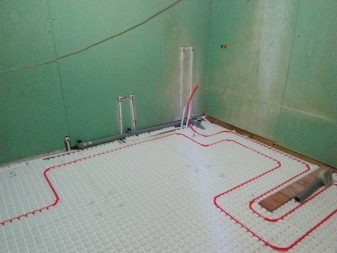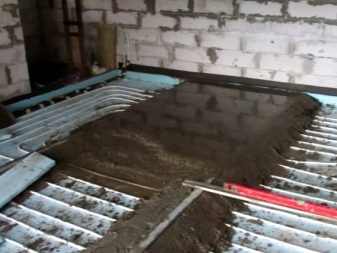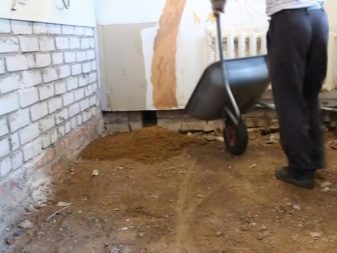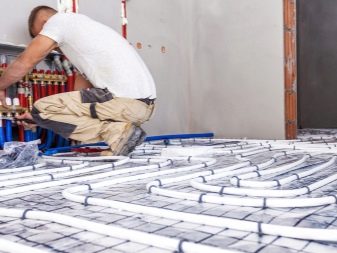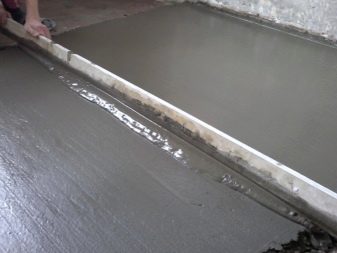Choosing a warm floor in the bathroom under the tile
Tile is one of the most common flooring options for a bathroom. It does not absorb moisture, is easy to clean and gives the room an original and stylish appearance. The only drawback is that such a coating is cold, which is especially felt if you stand on it with your bare legs right after a shower or bath. However, this problem can be eliminated by using the floor heating system. It provides heating of a tile (or the majority of other floor materials) to the necessary temperature.
Special features
The main characteristic of a warm floor is the ability to provide uniform heating of the floor tile to a pleasant temperature for the user.The heat carrier is water (special liquid) or electricity. The efficiency of the system is influenced by the power of the system and the features of its installation (pipe or cable pitch), the thickness of the screed, the characteristics of the floor covering. Heating of the room is carried out in layers.
First, the cable heats up (or the carbon strip, the pipe system depends on the type of underfloor heating), after which heat is given to the screed, from it to the floor covering.
When installing a heated floor in the bathroom, it is important to take a responsible approach to choosing a waterproofing film.and also protection of system against penetration of moisture from a floor covering. To do this, you need to purchase special floor tiles for wet rooms with a minimum moisture absorption rate and special moisture-proof protection.
Device
The principle of the system due to its appearance. So, the water heat-insulated floor represents a system of the pipes mounted under a floor on which hot water circulates. Pipes are connected to the central heating system or a separate boiler. Fluid circulation is provided by special pumps, a concrete screed is performed on the pipe system, and tile is glued to it.
Floor heating with an electrical system is carried out using heating wires.
They can be of the following types:
- separate - such wire keeps within with a certain step on all area of the room;
- unite in mats - more convenient for installation option.
There are more modern film systems. The source of heat energy in these structures is electricity. Most electric floors do not imply a screed, the tile is glued directly onto a thin adhesive layer.
Advantages and disadvantages
The main advantage of the system is the ability to ensure optimum floor temperature and improve the performance properties of floor tiles. When this occurs, uniform heating of the floor, and hence the room. For comparison, heating radiators heat up the space around them a lot, while at the far end of the room the floors can remain icy.
The advantage of the device is that it does not warm the air in the room, which causes its dryness, but the floor itself and the objects that give off heat.
Through the use of the system, it is possible to create a favorable microclimate in the bathroom. This is due to the fact that the temperature in the lower part of the room is 2–3 degrees higher than in the upper part. Such a microclimate is considered to be the most beneficial to health, since overcooling of the feet is prevented. The aesthetics of the system should be added to the advantages of the system - all the heating elements are hidden by the self-leveling floor or tile, only the control panel is mounted on the wall. Manufacturers strive to make it as ergonomic and pleasant as possible.
An indisputable advantage is the ability to adjust the temperature due to the presence of thermostats and a control panel. If we talk about electrical models, then users have the ability to adjust the heating up to one degree. It takes a little time to heat the surface, after which the system can be switched to a more economical mode of maintaining the specified parameters. When using a heated floor system, energy costs are 4 times cheaper than connecting various electric heating radiators. Compatibility with a large number of flooring is another clear advantage. The presence of the system does not affect the strength and durability of the tile.
The advantages and disadvantages of the device are largely due to its appearance. So, water heated floor is more economical than electric, but has a limited scope of use and is characterized by a complex, expensive installation. For the organization of such a system requires a large amount of preparatory work, wiring and laying of pipes, pouring them with a concrete screed. At the same time, the height of the floor will rise by an average of 10–15 cm. Moreover, such a system is heavy and unsuitable for installation in an apartment building, since when connecting the system in one apartment, the neighbors in the riser will remain without heat. Water floor heating is suitable for private houses with a strong foundation and rather complicated to install. However, its further operation will be very economical.
As for the electrical analog, on the contrary, it is easy to install. As a rule, stacking and connection can be done by hand. However, during the operation should be prepared to increase electricity bills. In addition, like any electrical device, such a device requires compliance with the rules of wiring, grounding and emergency shutdown systems.In case of violation of these requirements or operation of a faulty unit, there is a high probability of fire.
Often, speaking of the shortcomings of electropolishing, declare their electromagnetic radiation. In fact, such judgments are erroneous, because heated floors are not the source of a large amount of electromagnetic waves unsafe for health. They emit about as many electromagnetic waves as a mobile phone. When choosing a more expensive infrared models can not completely protect themselves from such radiation.
Types of systems
There are two large groups of warm floors.
Water
The coolant here is water or non-freezing liquid circulating through flexible plastic pipes that are laid on the floor.
Electric
These devices can have several types.
Cable system
One of the simplest floor heating systems. It is an electrical wire with a conductive conductor characterized by high resistance. The current flowing through it causes heating of the cable and, accordingly, activation of the system.
Cable devices are single and twin.Cables with one residential unit are cheaper, but their installation is somewhat complicated by the need to pull both ends of the cable to one point when connected to the power grid. It is not necessary to do this when working with twin-core analogs, since the two conductor cores inside are already interconnected, there is no need to reduce them when connected. Prevention of fire allows the presence of insulation and screen on each core.
Speaking about the cable system, it is worth to single out a self-regulating cable separately. Instead of a conductor, it contains a semiconductor. Thanks to this design, the cable resistance depends on the ambient temperature. In other words, the heating process is automatically controlled according to the temperature in the room. The use of self-regulating cable helps prevent system burnout, provides a more economical power consumption.
All cable systems are stacked on the floor with a snake with a certain pitch, a thin layer of screed is made on top of it (30–50 mm thick), after which it is possible to start laying the tile.
Heating mats
The basis is strong heating cables, which are fixed on a special grid. The cable pitch is already set; it is usually 9 cm. The average width is 50 cm, the length depends on the brand and the material model. Convenience heating mats due to the simplicity of their installation, the ability to cut a plastic base and perform the necessary turns and bends of the system. The advantage is the ability to abandon the screed and laying the tile over a thin (8–10 mm) layer of tile adhesive. This is due to the use of small-diameter cables in mats.
Infrared film
This is a relatively new type of warm floor, which is a multi-layered “pie” with carbon stripes as a heating element. They are laid on a substrate, non-conducting current. Electricity to the heating strips moves along the conductive veins of copper or silver, on top of the carbon strips are closed with the upper protective layer. A characteristic feature of the material is its small thickness - 0.4 mm, the maximum heating temperature rarely exceeds + 50ºС. This makes the infrared floor optimal under the "capricious" and unstable to high temperatures, floor coverings (linoleum,carpet, parquet).
If we talk about laying infrared film under the tile in the bathroom, then you can not do without the filler system. Only this way it is possible to install an infrared heat-insulated floor in rooms of high humidity. Not every type of this device is approved for use under a wet screed. A kind of infrared floor heating are systems where the heating element is laid out not in strips, but in a continuous layer.
Infrared heating is considered the safest, since the radiated heat is similar to what the sun "gives off".
Heating infrared rods
This type of floor combines the features of cable and film floor. Instead of carbon bands, carbon rods are used here, which are also fixed on a thin non-conductive base. The finished product does not heat up as a cable analogue, but, unlike the film floor, it can have a higher heating temperature (+ 50–60 ° C) and several types of installation to choose from (in a screed or on a layer of tile glue).
Design and types of tiles
Choosing a tile for a warm floor should be given preference to options designed for laying on the floor.They are characterized by wear resistance, high strength and a special anti-slip coating. If the electric or water floor is the only source of heating, then the tile must withstand heating up to + 24–31ºС. If there are other sources of heat, it is enough if the temperature range of heating is + 16–26ºС. Ceramic, clinker or porcelain stoneware tiles should be preferred. Heating, they retain heat and give it away gradually, which provides a more comfortable use of the floor and the ability to save energy consumption (especially if self-regulating heating cables are installed).
As for the size and design of the tile, their choice depends solely on the personal preferences of the owner. Many dream of wood flooring, which is associated with family warmth and comfort. However, even properly treated wood is not recommended for use in the bathroom due to the impracticality of the material. The output will be the use of ceramic tiles under the tree. Using this or that technology, you can achieve an imitation of parquet or wooden floor, covered with planks.
The brown shade of the tile goes well with the warm coffee walls. The unity of style can be achieved by using a mosaic and the same material on the floor for finishing the bath panels. Due to this, it will be possible to achieve the effect of transition of horizontal surfaces (floor) into vertical ones. It is not recommended to “delimit” this smooth transition using bath mats. However, when installing a heated floor and they will not be needed.
When decorating the floor with a dark tiled floor, it is recommended to “support” it in the wall decoration. The classic solution is to use a small curb of a dark shade to match the floor, "light" on the wall of light colors. If the task is to visually raise the ceiling, instead of a border, it is worth using narrow vertical lines made of a darker shade of the tile than the main part of the wall.
Beautiful interior is obtained by using tiles associated with a water coating. These are all shades of blue, blue, aquamarine, which can be combined with white or beige tiles. For classic interiors, you can use a tile with a geometric print.Original and original look "pictures", lined with tiles. The most popular subject of such images is sea.
How to do it yourself?
In general, installation of a heated floor includes several steps.
- The first is laid out hydrolayer, and then the insulating material. The task of the latter is to warm the room, reduce its heat loss.
- A warm floor should be laid on top of it, which should be poured with a tie or a thin layer of tile adhesive. After the fill is completely dry, you can begin to lay the tile.
- It is important that the insulation can withstand temperatures up to + 100ºС. If the bathroom is located on the second floor of a private house, you can use thin foil-based insulation. In this case, the heat that leaves the bathroom through the floor will “serve” in the room on the lower floor.
- In an apartment building or when the bathroom is located on the first floor, a thicker insulation should be used (for example, extruded polystyrene foam plates). This will reduce heat loss.
- Draft floor must be clean and dry, in the presence of holes and mounds, the floor must be leveled.It is convenient to use self-leveling compounds for this or to pour cement-concrete mortar in the old-fashioned way, focusing on the beacons.
- The installation of the electric floor should begin with installation on the wall of the thermostat. This device, on the screen of which data on floor heating is transmitted, has a control panel. The thermostat must be at least 30 cm high from the floor. Experts recommend mounting the thermostat outside the bathroom. This will avoid the oxidation of its contacts due to the increased humidity in the bathroom.
- Connect the thermostat with the heating system allows the wire, which fits into the groove in the wall. When using cables, they must be covered with a reinforcing mesh, which also fixes the cable. After connecting and checking this system, a warm floor can be covered with a tie or a thin layer of tile adhesive. After drying, they start laying the tile.
- Installation of water floors is also carried out on the waterproofing layer. The material must be laid with a 10 cm spade on the walls. A damper tape is fastened around the perimeter, which is designed to eliminate the “cold bridges”.
- On top of the waterproofing layer is placed insulation, for example, polystyrene foam plates. Then a shield is installed to control the heating equipment. When choosing its location, it is important that the guard is not cluttered with furniture or plumbing.
- The pipes are laid out, fixed on the floor, and then connected to the shield and the water supply system by means of flexible hoses. All joints must be carefully sealed. It is more convenient to check the quality of pipe insulation with a pressure gauge.
- If the system is in good condition and sealed, you can start pouring the screed. It is a mixture based on fine concrete or cement-sand base. It is necessary to level the level of the floor with the help of beacons, then the screed is poured, leveled and ground. After solidification of the cement or concrete layer, you can turn on the heating system.
Tips and tricks
Before buying, you should decide on the power of a warm floor. This is determined by whether the system is a primary or secondary source of heating. In apartment buildings, there are usually stationary radiators for heating, therefore, a sufficiently warm floor with a capacity of 80–100 W / m².
If we are talking about an unheated room, then the power is calculated by heat loss, in any case, for a bath this figure should be at least 130–160 W / m².
After determining the power of the electric field, you must select the type of system. For the bathroom, it is most convenient to use heating mats, since they are easy to install and do not “eat up” the height of the room due to a thin layer of tile adhesive. If the premises are quite high, then you can use cable floor heating, laying them in the screed. True, the process will be more time consuming. If means allow, you can choose the most expensive variety - these are heating infrared rods, and the tiles on them should be laid on a thin tile layer. This will reduce the complexity of the process and avoid a strong increase in the level of the floor.
In a private house, where the height of the premises allows you to "give" under the warm floor and concrete screed 15-17 cm, you can use water-heated floors. Before installation, it is also important to correctly calculate the thermal efficiency of the system, to determine the pipe installation step and the layout of the wiring. Due to the complexity of installation and its high cost, it is better to entrust these works to professionals.
To increase the efficiency of the system, as well as to prevent its overheating, allows following several recommendations.
- To prevent irrational heating will allow the distance between the warm floor and the walls of the room. The recommended figure for this distance is 5 cm.
- It is unacceptable to lay a warm floor next to radiators less than 10 cm distance. When heated from the radiator, the system will not be able to give off heat, which will cause overheating and, as a result, a short circuit of the cable.
- For the same reason (the inability to completely give off heat) one should not lay warm floor under massive furniture without legs.
- Overheating of cables and system failure can cause excessive cable laying (less than 8–9 cm), as well as intersection of cable lines.
- During the installation process it is important to prevent accidental breaking of the cables. You can prevent this by wearing soft-soled shoes and minimizing movement on the cable fixed to the floor. Some experts close the cables laid on the floor with sheets of plywood or chipboard.
- When organizing a water heated floor, it is necessary to leave the pipes under pressure when pouring the screed.This will avoid their deformation under the weight of the composition for the screed.
- If the warm floor is installed in an already inhabited house, then to install it, remove the old flooring. When it is knocked down, the screed under it is most likely deformed. You should not try to restore it, it will be easier and cheaper to knock it down, level the surface and fill in a new layer. When using heating mats, they can be laid directly on top of the old tile. This simplifies and speeds up installation, although this method increases the thickness of the floor.
- To test the system after installation, it is better to use special devices that allow you to set the system voltage. If the obtained figures correspond to those stated in the device instructions, you can begin to fill the floor.
- At the time of drying screed is not allowed to include a warm floor, it will lead to deformation of the screed layer. Turn off the warm floor is necessary when laying tiles. The glue should dry out under the most natural conditions.
- To protect the flooring will allow the use of moisture-resistant grout for tiles.
On how to properly install a warm floor in the bathroom, see the following video.
